At the time of writing – February 2013 – we were already witnessing the most dramatic airline story of the year – perhaps even the decade – with the proposed US$11 billion merger between giants US Airways and American Airlines to create the world’s largest airline. Behold the new American Airlines – bigger, bolder and better than ever before.At the time of writing – February 2013 – we were already witnessing the most dramatic airline story of the year – perhaps even the decade – with the proposed US$11 billion merger between giants US Airways and American Airlines to create the world’s largest airline. Behold the new American Airlines – bigger, bolder and better than ever before.
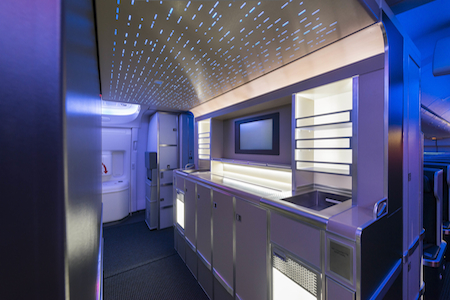
The headlines began in 2011 when American’s aggressive fleet-renewal plan started taking effect, with the first of its 737-800s with the Boeing Sky Interior being delivered in an order currently being completed. To ensure the airline has the youngest and most fuel-efficient fleet of any US carrier, the order book also includes 20 777-300s, which are currently being delivered; and 42 787s with an option for a further 58, with deliveries beginning in late 2014. American plans to take delivery of 130 A321 and A319 variants and 100 737-800s through 2017. Also beginning in 2017, American will take delivery of 130 next-generation Airbus aircraft (NEO) and beginning in 2018, the airline plans to take delivery of 100 next-generation 737 MAX aircraft. American plans to configure some of the A321s for use on transcontinental flights and intends to use the remaining A321s, as well as all of the A319s and new 737-800s to retire aging aircraft in its existing fleet.
An impressive amount of work has gone into making sure the interiors of these aircraft offer a level of luxury that matches American’s might. The airline invited design agencies to pitch for the contract in late 2010, and by early 2011 London-based JPA Design had secured the contract and was beginning work on the interior of the 777-300s – the first such aircraft to be ordered by a US airline and the flagship of the new American fleet.
James Park, managing director of – and indeed the JP of – JPA Design explains the brief: “American was aware that the competition in other parts of the world was getting better all the time and they had the feeling they had to catch up. So the first thing they had to do was to look at the aircraft interiors. Essentially the brief was to bring the interiors up to a standard that was commensurate with the growing competition. If you go west from the USA to Japan, Singapore or Hong Kong, you can see the kind of competition they are up against, and the old American seating was not a patch on any of that. You wouldn’t have chosen American to fly to Hong Kong before, but now you would. In the context of the US market, it’s going to be a quantum leap.”
JPA’s design director Tim Manson adds, “American wanted us to transform the product range. They were aware of the marketplace and that they looked slightly tired compared with the rest of the world. They had a strong ambition to be the best. The pitch we presented gave us a good start as we were close to American’s aspirations. We made them believe they could have something different.”
To ensure the programme remained on track and could be translated to other aircraft, and even the new lounges, a design manual was drawn up to define design values. As each decision was made it was checked against specific criteria under chapters such as detail, long-lasting value, comfort for living and discovering opportunity. “We basically laid down the anchor for all the following design work and we’re very proud of that,” states Park.
777 first class
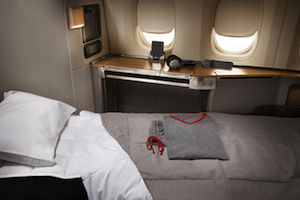 With the design values in place, it was time to begin the designs for the 777-300s, starting with the eight-seat first-class cabin, which was to set the standard for the entire aircraft. It was decided that the existing Flagship Suite was the best in the market in terms of density, living space and comfort, and its swivel function set it apart by allowing passengers to create an onboard office.
With the design values in place, it was time to begin the designs for the 777-300s, starting with the eight-seat first-class cabin, which was to set the standard for the entire aircraft. It was decided that the existing Flagship Suite was the best in the market in terms of density, living space and comfort, and its swivel function set it apart by allowing passengers to create an onboard office.
Thus, with time tight and the airline already offering what it believes to be the best first-class seat in the skies, at 29in-wide, with a 64in pitch and an 82.5in-long bed, it became a restyling, trim-and-finish project.
So it was back to the design manual, with the ‘comfort of living’ requirement being addressed through the textiles – textile design being a very US tradition. “We wanted to tap into the US culture and what it is known for. America has some very high design standards, with robust classics like the Eames chair. We wanted to reflect a little of that in the cabins,” says Manson, who worked with JPA’s trim team and the textiles supplier to make the ideas come to life.
A textural, organic and comfortable fabric was created, featuring a geometric pattern that repeats and builds. The aim was to create an honest, timeless design with a handcrafted element that is expressed through areas such as the leather stitching.
The composite wraparound seat shell was also refined to give balance to the cabin design and offer a warmer look, while also creating a smoother finish than the previous version with its exposed rivets and screw fixings. JPA also cleaned up the split lines of the side console, added a trinket tray, extended the rear shell to give more sleeping privacy, and removed the pull-out IFE screen, relocating the 17in Panasonic eX2 monitor to the shell in front.
Continuing the theme of tradition, wood finishes also became part of the design. “The introduction of wood laminates in first class was important to add a layer of quality and authenticity to the finishes,” explains Park.
As a finishing touch a lamp was added to the side. Next to the lamp is a small hatch, which when opened reveals connectivity ports and a vanity mirror.
“It’s a space that has visual interest in a number of areas. We hope it will create more emotional engagement, being friendly, functional and familiar,” says Park.
777 business class
American recognised that it needed a better business-class product, but time constraints meant that a bespoke design was impossible. However, a study of the world’s seats yielded a favourite, which in a happy coincidence was Cathay Pacific’s inverse herringbone design, originally created by JPA Design and based on the Sicma Cirrus. The design has been licensed from Cathay, and again, no major alterations were required, with the kinematics remaining unchanged, but the trim and finish work made the seat American’s own. To keep its original product a little special, Cathay has retained the bed extension that adds an extra 6.5in to the width.
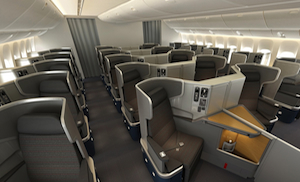 The 1-2-1 configuration at a 43in pitch also gives each of the 52 passengers direct aisle access, which is a big improvement on the outgoing 2-3-2 arrangement.
The 1-2-1 configuration at a 43in pitch also gives each of the 52 passengers direct aisle access, which is a big improvement on the outgoing 2-3-2 arrangement.
Gone is the sea of blue of the previous cabin, replaced by light grey metallic finishes on the shells, with grains and natural finishes surrounding the seat. These finishes pick up on those in first class and weave them through to create a cohesive feel. However, as a nod to the old, the lower portion of the shell is blue. “One of the harder jobs was to convince American that they could get away from an entirely blue cabin,” says Manson.
Park adds, “I think the first and business-class finishes align really well with the livery and experience, which is due to the principles and references we laid down in this exercise. In general we were aiming for the designs to be practical and not over the top. The result is the best premium cabins in America – they have a generous quality to them with a strong and durable, well-made feel.”
Business-class bar
All passengers board via the walk-up bar area in business class, which American wanted as a way to create a positive impression of the journey upon boarding end exit, and as a further temptation for valuable business travellers to fly American.
 The 787-style domed entryway ceiling gave JPA the opportunity to create something a little different. “The dome light created the perception that the cross aisle was darker than usual, so we introduced an illuminated pattern on the underside of the cross-aisle ceiling. This added a level of interest you wouldn’t expect and became a bit of an iconic entrance. A lot of ingenuity went into how that bar ceiling was made, installed and maintained,” explains Manson, though he won’t reveal the secrets of the ceiling’s materials and construction.
The 787-style domed entryway ceiling gave JPA the opportunity to create something a little different. “The dome light created the perception that the cross aisle was darker than usual, so we introduced an illuminated pattern on the underside of the cross-aisle ceiling. This added a level of interest you wouldn’t expect and became a bit of an iconic entrance. A lot of ingenuity went into how that bar ceiling was made, installed and maintained,” explains Manson, though he won’t reveal the secrets of the ceiling’s materials and construction.
However it was created, the result of the bar area is that upon boarding you have a feeling that you are entering a living space rather than just another tube.
777 economy
The character of the 220-seat main cabin is very different from the premium cabins, recalling a little more of the traditional American, with blue fabric covering the seats. “We wanted to introduce a fabric that is easily identifiable with American Airlines and has a different scale to the design that makes it a little more interesting for today and the future,” states Manson. Thus the small squares of old are replaced with a much larger pattern, closer to a check, and the armrests remain a pale grey.
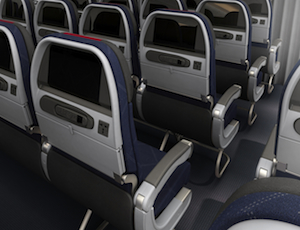 As in the previous cabin, the headrests are leather, though it is now a rich grey colour, and is indeed the same grey found on every headrest in the aircraft, though the grain becomes finer as you move up the classes. A strip of red leather at the top of the headrest lifts the whole look.
As in the previous cabin, the headrests are leather, though it is now a rich grey colour, and is indeed the same grey found on every headrest in the aircraft, though the grain becomes finer as you move up the classes. A strip of red leather at the top of the headrest lifts the whole look.
The Weber 5751 seats are a tight 10-abreast 3-4-3 at 31in pitch, and are standard except for a unique seatback. To present the 9in Panasonic Eco Monitor to best effect, the shell was redesigned for a softer shape, with a grey screen bezel. Move up to the 30-seat premium economy, and you’ll find the same seat, only with a 36in pitch and an extra inch of width, configured 3-3-3.
Transcontinental fleet
Indeed even the issue of American filing for Chapter 11 protection in November 2011 couldn’t disrupt the project, and JPA started working on the airline’s transcontinental A321s in a parallel project, together with the A319s, B777-200s, B737s, B767s and B787s. At present we have only seen designs for the transcon A321s and domestic A319s.
The key to the transcontinental A321T designs goes back to that ambition to be the best: customers flying coast to coast with American will now enjoy three-class aircraft. Of course, this isn’t the first three-class transcontinental offer, but it is the first to offer a first-class cabin with fully flat seats, like you’ll find on twin-aisle aircraft. However, it was not a simple case of specifying the seats from the 777 cabin, or even the same trim and finish, for the A321, as Manson explains: “Consistency came into the dialogue. It wasn’t about copying arrangements into other seats. It was about making sure the design language was consistent, so shape and form, as well as product offering, detailing, trim and finish were used to create a cohesive product that is recognisably American. So you can get off a transatlantic first-class flight and get onto a first-class transcontinental flight with some continuity.”
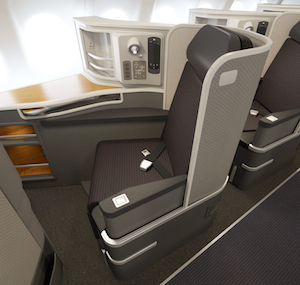 The key was that design manual. In first class, for example, the 10 Sicma Skylounge seats, arranged 1-1, though a different proposition from the 777 seat, have received shell treatments to make them instantly recognisable to international American flyers. The seat is similar to those found in EVA’s Royal Laurel class, but the single-aisle application left a wide aisle space, which in turn meant that an extra 6in could be added to the console width, which also translates to extra bed width.
The key was that design manual. In first class, for example, the 10 Sicma Skylounge seats, arranged 1-1, though a different proposition from the 777 seat, have received shell treatments to make them instantly recognisable to international American flyers. The seat is similar to those found in EVA’s Royal Laurel class, but the single-aisle application left a wide aisle space, which in turn meant that an extra 6in could be added to the console width, which also translates to extra bed width.
“The 1-1 configuration in first class is a bold move. There aren’t any other cabins like that and it’s going to make a massive difference to the market,” says Manson.
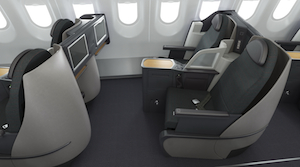 In business class the 20 guests receive an executive favourite – the B/E Diamond. It is a fairly stock seat, but as Manson says, “We made one minor change. We fought for a bespoke finish to remove the industrial look and it was a small victory. The challenge was to work out how to enhance the seat above and beyond a relatively plain product, and we had three cards up our sleeve. The main one was that on the rear shell we introduced microfinish paint, which has a lovely soft sheen that gives the shape a little more movement. We also use a consistent fabric with a textural, handmade feel, which is the American language again. And we boosted that feel with wood and a nice metallic silver-grey finish on the sidewalls.
In business class the 20 guests receive an executive favourite – the B/E Diamond. It is a fairly stock seat, but as Manson says, “We made one minor change. We fought for a bespoke finish to remove the industrial look and it was a small victory. The challenge was to work out how to enhance the seat above and beyond a relatively plain product, and we had three cards up our sleeve. The main one was that on the rear shell we introduced microfinish paint, which has a lovely soft sheen that gives the shape a little more movement. We also use a consistent fabric with a textural, handmade feel, which is the American language again. And we boosted that feel with wood and a nice metallic silver-grey finish on the sidewalls.
There is also a treat for the 36 economy and 36 premium economy passengers, who will be the first to try Recaro’s CL3620 seat with the high literature pocket, which JPA had verified and tested for this application. JPA also worked with Recaro to better integrate the 9in IFE touchscreen, and specified a stowage net. The economy seats are trimmed in the same fabrics as the 777 seats.
Domestic A319
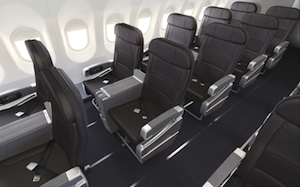 For domestic flights of around three hours, passengers on the forthcoming A319s will again enjoy an experience that is clearly ‘new American’, albeit a simplified two-class version. In the 12-seat first-class cabin (pictured right), the seats feature 12.1in IFE screens, and will be trimmed in the same grey leather found on the headrests throughout the rest of the new fleet.
For domestic flights of around three hours, passengers on the forthcoming A319s will again enjoy an experience that is clearly ‘new American’, albeit a simplified two-class version. In the 12-seat first-class cabin (pictured right), the seats feature 12.1in IFE screens, and will be trimmed in the same grey leather found on the headrests throughout the rest of the new fleet.
In economy, Recaro seats have again been specified, with 9in IFE screens, and trimmed in blue leather to provide the extra durability and lower maintenance requirements needed for the shorter turnarounds.
All American
It’s quite a project: two years from the initial pitch to the first of American’s new 777s taking to the skies, with designs in place for eight different aircraft types, different seat types with multiple vendors – 10 seat types from seven vendors across the entire project – and multiple leathers and textiles from different vendors. And all this with a cohesive design rather than simple duplication. This is certainly the biggest aircraft interiors project we’ll see for quite some time.
As Park concludes, “It has been a really special opportunity to work on so many products over a fleet in a focused timeframe. I hope we’ll get the opportunity again, but such moments don’t come around that often. It was a very brave undertaking by American and it was a tricky year, but the results were excellent and working with American was good fun.”




